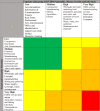Strengthening Social Compact and Innovative Health Sector Collaborations in Addressing COVID-19 in South African Workplaces
- PMID: 36650981
- PMCID: PMC9852971
- DOI: 10.1177/10482911221150237
Strengthening Social Compact and Innovative Health Sector Collaborations in Addressing COVID-19 in South African Workplaces
Abstract
Workplaces are nodes for Severe Acute Respiratory Syndrome Coronavirus 2 transmission and require strategies to protect workers' health. This article reports on the South African national coronavirus disease 2019 (COVID-19) strategy that sought to ensure workers' health, protect the economic activity, safeguard livelihoods and support health services. Data from the Occupational Health Surveillance System, Surveillance System of Sentinel Hospital Sites, and government databases (public sector health worker and Compensation Fund data) was supplemented by peer-reviewed articles and grey literature. A multipronged, multi-stakeholder response to occupational health and safety (OHS) policy development, risk management, health surveillance, information, and training was adopted, underpinned by scientific input, through collaboration between government, organized labour, employer bodies, academia, and community partners. This resulted in government-promulgated legislation addressing OHS, sectoral guidelines, and work-related COVID-19 worker's compensation. The OHS Workstream of the National Department of Health provided leadership and technical support for COVID-specific workplace guidelines and practices, surveillance, information, and training, as well as a workplace-based vaccination strategy.
Keywords: COVID-19; framework response; multistakeholder collaboration; risk mitigation; workplaces.
Conflict of interest statement
The author(s) declared no potential conflicts of interest with respect to the research, authorship, and/or publication of this article.
Figures





Similar articles
-
Occupational factors in the COVID-19 pandemic in Italy: compensation claims applications support establishing an occupational surveillance system.Occup Environ Med. 2020 Dec;77(12):818-821. doi: 10.1136/oemed-2020-106844. Epub 2020 Sep 23. Occup Environ Med. 2020. PMID: 32967988 Free PMC article.
-
Perspective of Workers’ Union Representatives on COVID-19 Measures in Turkish Workplaces in the First Year of the Pandemic.Balkan Med J. 2023 Mar 8;40(2):124-130. doi: 10.4274/balkanmedj.galenos.2023.2022-10-116. Epub 2023 Feb 7. Balkan Med J. 2023. PMID: 36748248 Free PMC article.
-
COVID-19 Outbreak in Italy: Protecting Worker Health and the Response of the Italian Industrial Hygienists Association.Ann Work Expo Health. 2020 Jul 1;64(6):559-564. doi: 10.1093/annweh/wxaa044. Ann Work Expo Health. 2020. PMID: 32298415 Free PMC article.
-
Worker and employer experiences with COVID-19 and the California Workers' Compensation System: A review of the literature.Am J Ind Med. 2022 Mar;65(3):203-213. doi: 10.1002/ajim.23326. Epub 2022 Jan 29. Am J Ind Med. 2022. PMID: 35092626 Free PMC article. Review.
-
Review of Occupational Health and Safety Organization in Expanding Economies: The Case of Southern Africa.Ann Glob Health. 2015 Jul-Aug;81(4):495-502. doi: 10.1016/j.aogh.2015.07.002. Ann Glob Health. 2015. PMID: 26709281 Review.
References
-
- Purkayastha D, Vanroelen C, Bircan T, et al. Work, health and COVID-19: a literature review. Report 2021.03, European Trade Union Institute, Brussels, 2021.
Publication types
MeSH terms
LinkOut - more resources
Full Text Sources
Medical

